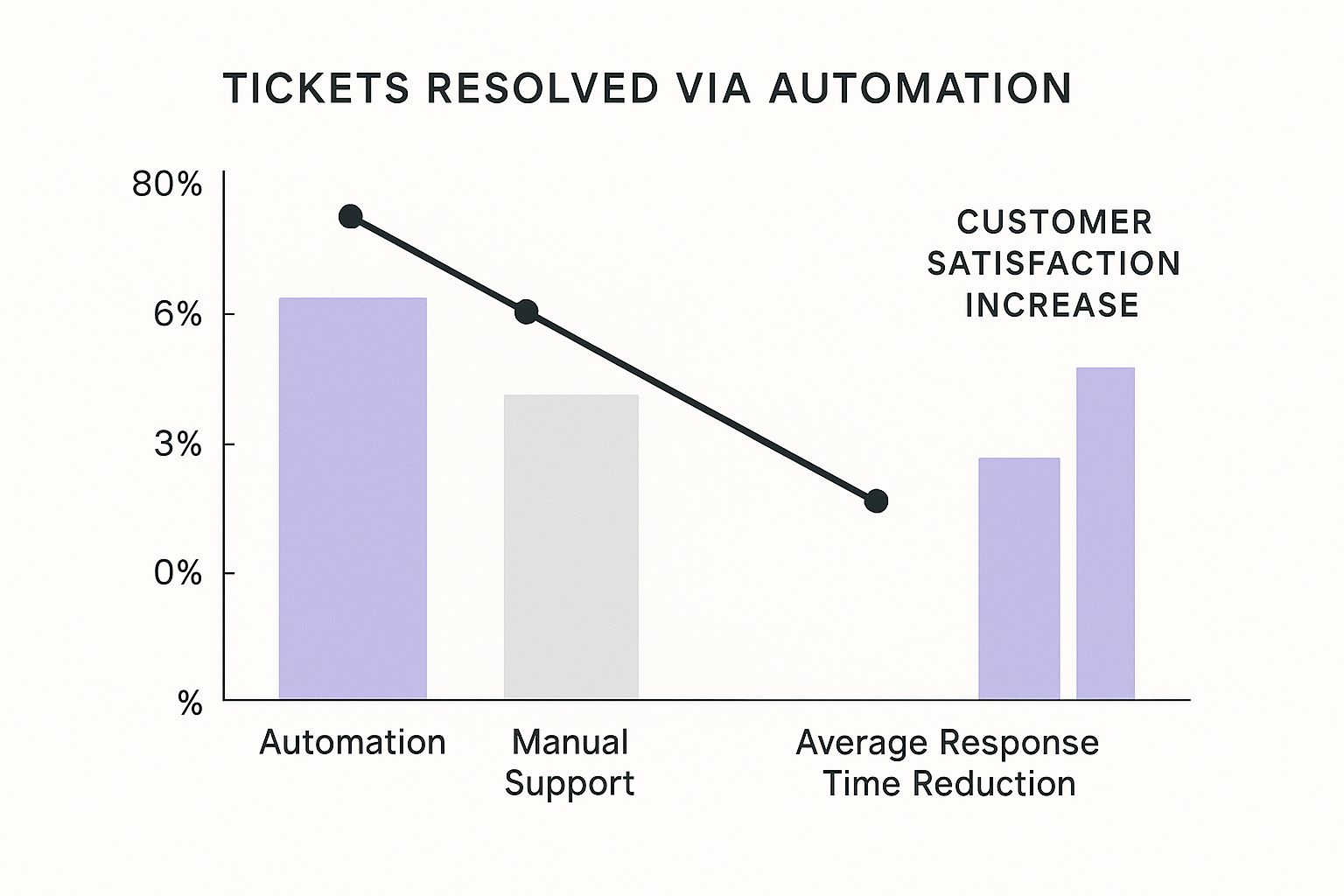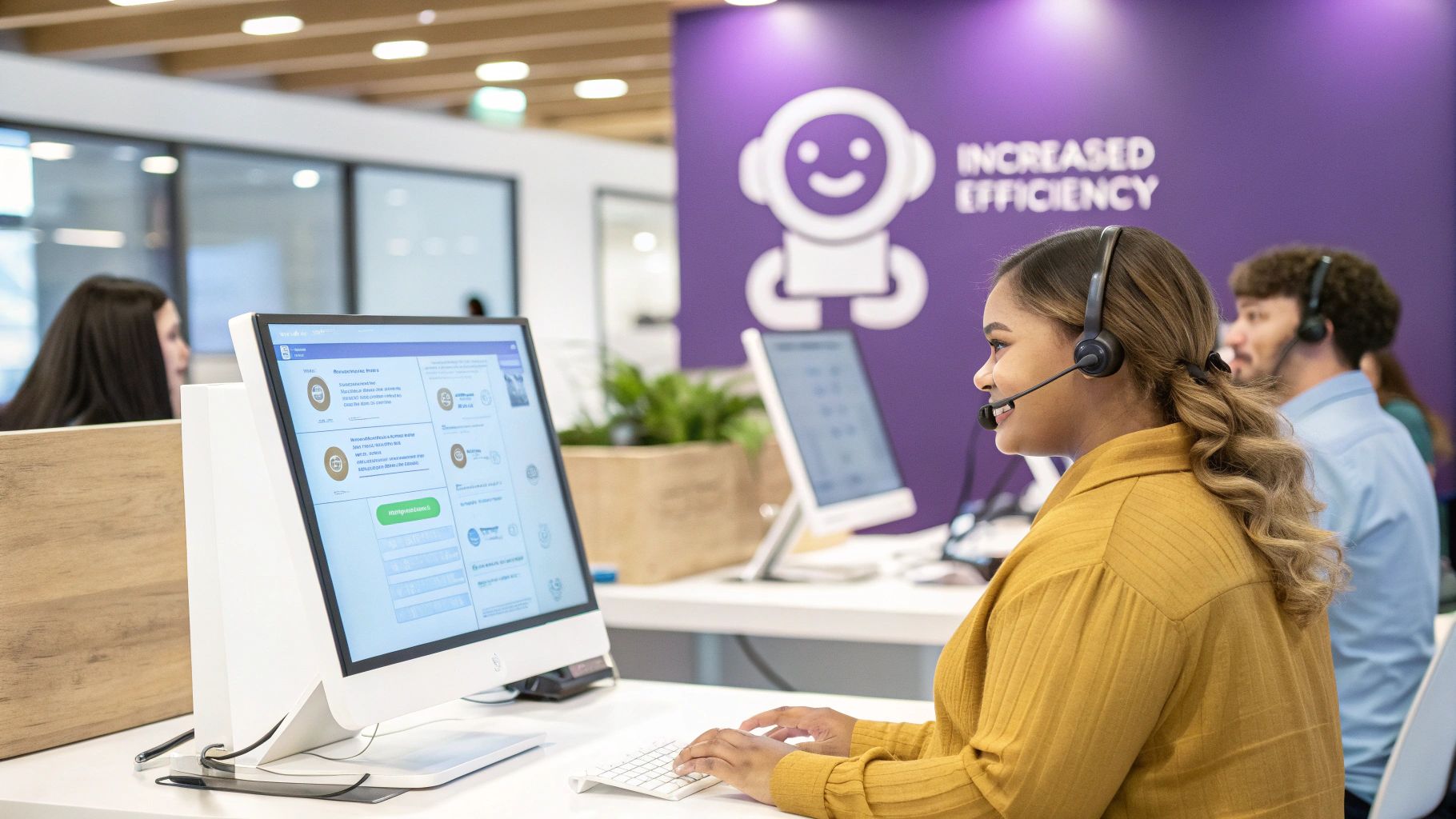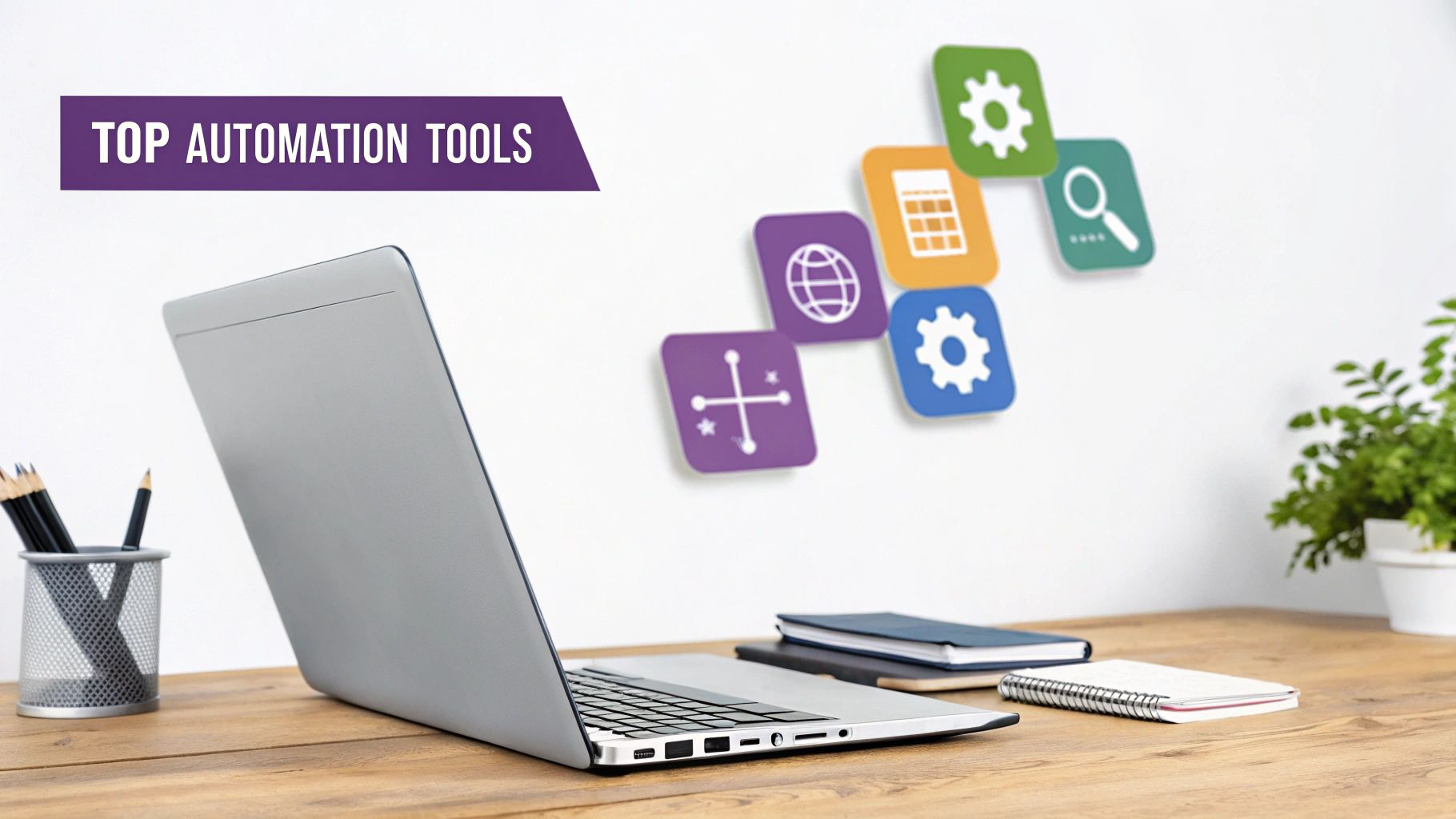The Evolution of Customer Support Automation

The data chart above illustrates the adoption rates of different customer support automation tools across various industries. It's clear that some sectors are embracing these new technologies more readily than others. The evolution of customer support automation has brought forth a wide range of technologies, from simple Interactive Voice Response (IVR) systems to complex AI-powered solutions. Platforms like WordPress have been part of this evolution. This progress shows how important it is for businesses to provide efficient and cost-effective support, all while keeping customers happy, starting with an overarching digital transformation roadmap. It also highlights the growing intricacy of customer interactions and the increasing need for 24/7 support.
Current State of Automation Adoption
Customer support automation isn't some far-off dream; it's happening now. However, the extent to which companies use and understand this technology differs greatly. Some businesses are leading the charge, using AI and machine learning to create personalized experiences and address issues proactively. Others are lagging behind, stuck with basic chatbots and static FAQs.
This gap creates a significant difference between successful businesses and those struggling to stay current. For actionable insights, check out our customer service manager tips. This division is apparent in the data chart, which compares the adoption rates of various customer support automation tools across different industries. For instance, AI-powered chatbots are much more common in the tech sector than in traditional industries like manufacturing. This indicates that some sectors are embracing new technologies while others are falling behind.
To better understand current adoption rates, let's look at the following table:
"Current Adoption Rates of Customer Support Automation Tools" "This table shows the current adoption rates of various customer support automation technologies across different industries"
| Automation Technology | Average Adoption Rate | Industry Leaders | Industry Laggards |
|---|---|---|---|
| AI-powered Chatbots | 45% | Technology, E-commerce | Manufacturing, Healthcare |
| IVR Systems | 70% | Telecommunications, Finance | Education, Non-profit |
| Automated Email Responses | 85% | Marketing, Sales | Government, Utilities |
| Live Chat Software | 60% | Customer Service, Retail | Construction, Agriculture |
This table offers a glimpse into how various industries are adopting automation technologies. As you can see, the adoption of AI-powered chatbots, while growing, still lags behind more established technologies like IVR and automated email responses. The difference between industry leaders and laggards highlights the competitive edge gained by early adopters of advanced automation.
The Rise of AI and the Untapped Potential
Customer support automation has become increasingly crucial. One key trend is incorporating AI and automation in contact centers. As of 2025, only 25% of call centers had integrated AI automation, indicating significant room for growth. For more statistics, check out this resource: Customer Service Statistics. This underutilization presents a substantial opportunity.
Businesses can adopt AI technologies like natural language processing (NLP) and robotic process automation (RPA) to automate routine tasks and boost efficiency. AI can assist in predictive analytics for better staffing forecasts, while RPA can automate data entry and call routing. These improvements free up human agents to address more complex customer issues, ultimately leading to greater customer satisfaction and improved profitability.
Beyond Cost Cutting: The True ROI of Support Automation

While reducing expenses is a key motivator for implementing customer support automation, the real return on investment (ROI) goes much further. Businesses should look beyond the initial savings and consider the broader, long-term advantages. Automation can significantly improve key performance indicators (KPIs) like first-contact resolution rates, directly impacting customer satisfaction and operational efficiency.
Improving First-Contact Resolution Rates
One of the most significant benefits of automating customer support is the improvement in first-contact resolution (FCR) rates. Automated systems, such as AI-powered chatbots and comprehensive knowledge bases, provide instant answers to common questions. This empowers customers to resolve issues quickly and independently.
This reduces the workload on human agents and helps reduce support tickets, improving the customer experience by minimizing wait times and effort. Higher FCR rates also contribute to lower operational costs and increased agent productivity.
Boosting Customer Lifetime Value
Automation plays a crucial role in boosting customer lifetime value (CLTV). By providing seamless and personalized support, businesses can cultivate customer loyalty and improve retention.
This leads to higher revenue over time, as satisfied customers are more likely to make repeat purchases and recommend the business. Automated systems can personalize offers and promotions, increasing sales and upselling opportunities.
Reducing Agent Turnover
Customer support automation can significantly reduce agent turnover. Automating repetitive tasks frees up human agents to handle more complex and engaging interactions.
This boosts job satisfaction and reduces burnout, leading to higher employee retention. Lower turnover minimizes recruitment and training expenses, further enhancing the ROI of automation.
Building a Business Case for Automation
Realizing the full ROI of customer support automation requires a clear strategy and implementation plan. This involves identifying key areas for automation, choosing the right tools and technologies, and establishing metrics to track progress. A well-defined roadmap ensures successful implementation and helps build a compelling business case for future investment in automation.
To illustrate the potential ROI, let's consider some key metrics:
ROI Metrics for Customer Support Automation Implementation
A comparison of key performance indicators before and after implementing support automation technologies
| Performance Metric | Before Automation (Average) | After Automation (Average) | Improvement Percentage |
|---|---|---|---|
| First-Contact Resolution Rate | 60% | 80% | 33% |
| Customer Satisfaction Score | 3.8/5 | 4.5/5 | 18% |
| Agent Turnover Rate | 25% | 15% | 40% |
| Average Handling Time | 10 minutes | 5 minutes | 50% |
| Cost per Contact | $5 | $2 | 60% |
This table highlights the potential improvements across various metrics. The significant increase in FCR and customer satisfaction, coupled with reduced agent turnover and handling time, demonstrates the substantial positive impact of automation. Furthermore, the considerable decrease in cost per contact underscores the financial benefits.
Solutions like FlowGent AI can assist in this process. They provide a no-code platform to deploy intelligent AI agents, integrate with existing tools, and offer multilingual support, ultimately scaling customer service and boosting efficiency. This allows businesses to focus on strategic growth, rather than repetitive support tasks.
The AI Revolution Transforming Customer Support Automation

Customer support is changing. It's moving beyond simple automated chatbots and into a new era of intelligent systems powered by Artificial Intelligence (AI). This shift is dramatically changing what's possible, pushing past basic decision trees and scripted responses.
Sentiment Analysis: Understanding Customer Emotions
One of the most impactful changes is sentiment analysis. AI can analyze customer communications like emails and chats, even detecting emotions from voice tone. This allows support systems to identify frustrated customers before small issues turn into big problems.
For example, if a customer says they are "extremely disappointed," the system can flag the conversation for a human agent. This proactive approach improves customer satisfaction and helps prevent negative experiences.
Predictive Intelligence: Anticipating Customer Needs
Predictive intelligence is also transforming customer support. AI algorithms analyze customer data to anticipate their needs. Think of it like a streaming service recommending shows based on your viewing history.
In customer support, this means suggesting helpful resources, offering proactive solutions, or routing inquiries to the right agent. This personal touch improves efficiency and creates a positive customer experience.
Natural Language Understanding: Handling Complex Scenarios
Natural Language Understanding (NLU) allows AI to handle complex support situations. NLU lets AI understand context and nuances in human language. This means AI can go beyond simple FAQs, troubleshooting issues and guiding customers through complex processes. It can even offer personalized recommendations.
The use of AI in customer support is increasing, with AI becoming more autonomous in handling tasks like troubleshooting and decision-making. This shift toward agentic AI is expected to rise in 2025. More detailed statistics can be found here. As AI continues to advance, we can anticipate even more sophisticated automation in customer service.
Building a Learning Support Ecosystem
Companies are now creating support systems that constantly learn and improve. AI analyzes every conversation, identifying patterns and refining its responses using customer interaction analytics. This ongoing learning process ensures the support system becomes more efficient and accurate over time.
This not only addresses immediate customer issues effectively, but it also allows the entire system to evolve and provide better future support. Solutions like FlowGent AI empower businesses to utilize these advancements, allowing them to deploy intelligent AI agents and significantly improve customer experience. This allows human agents to handle more complex issues, creating a collaborative partnership between AI and human support.
The Human-Automation Partnership That Customers Actually Want

Customers aren't focused on the newest, shiniest customer support automation; they want solutions. Their priority is resolving issues quickly and efficiently. This means businesses need to strike the right balance between automated support and the personal touch of human interaction. Successful organizations are creating support experiences that combine the speed of automation with the personalized connection customers value, following best practices for customer service.
Understanding Customer Expectations
Customer expectations regarding automated interactions are nuanced. Sometimes, self-service is preferred. Customers want quick answers to simple questions through a knowledge base or a chatbot.
However, for complex or emotionally charged issues, human interaction becomes essential, supported by a robust ticket escalation process. They want empathy and understanding from a real person. Think of it like this: self-checkout is fine for a few groceries, but a cashier is preferable for a large, complicated order.
Determining What to Automate (and What Not To)
The key is to carefully consider which interactions benefit from automation and which require a human touch. A good framework considers the complexity and emotional weight of the issue.
Simple, frequent questions are perfect for automation. Password resets, order tracking, and basic product information can be easily handled by a chatbot or automated email. Conversely, complex technical issues, complaints, or emotionally charged situations are best addressed by human agents.
Creating Seamless Transitions
Smooth transitions between automated systems and human agents are critical for maintaining customer trust and satisfaction. Transparency is key. Customers should know when they are interacting with an automated system and have a clear, easy way to reach a human if needed.
Furthermore, the transition should be seamless, ensuring the human agent has access to the previous interaction history. This prevents customers from repeating themselves, a major source of frustration.
The Power of a Blended Approach
Platforms like FlowGent AI facilitate this blended approach. They provide businesses with no-code platforms to deploy AI agents for routine tasks while integrating with WhatsApp CRM integration. This empowers companies to provide 24/7 customer support with a personal touch.
AI handles routine inquiries, freeing up human agents to focus on more complex issues and build relationships with customers. This partnership between AI and human agents creates a more effective and satisfying support experience that meets the evolving needs of today’s customers. The combined approach reduces costs, increases efficiency, and boosts customer satisfaction. By strategically implementing customer support automation alongside human interaction, businesses can create a winning formula.
Building Your Customer Support Automation Roadmap
Creating a practical customer support automation program requires a clear strategy, much like planning a road trip. You need a map and a destination. This section offers a practical guide for building or improving your automation, leading to happier customers and a more efficient team.
Assessing Your Current Support Operations
The first step is understanding your current situation. Analyze your existing customer support processes. Identify pain points and areas where automation can help. Ask yourself key questions: Where do your agents spend the most time? What are the most frequent customer issues? Where are the bottlenecks slowing things down? For example, if your team spends significant time answering simple, repetitive questions, this is a prime opportunity for automation.
Identifying High-Impact Automation Opportunities
After understanding your current operations, identify high-impact automation opportunities. Focus on areas where automation provides the greatest return on investment. This often includes automating repetitive tasks, such as password resets, order status updates, or answering FAQs. Automating these tasks allows your human agents to focus on more complex customer issues, ultimately improving the quality of your support. This is similar to how factories use machines for repetitive tasks, freeing up human workers for specialized work.
Selecting the Right Automation Technologies
Choosing the right tools is crucial. Select technologies that align with your needs and integrate with your existing systems. This could involve implementing AI-powered chatbots for handling simple inquiries, using a knowledge base for self-service support, or utilizing workflow automation tools to streamline internal processes. A platform like FlowGent AI can be very helpful, offering a no-code solution for deploying AI agents across different channels.
Creating and Implementing Your Automation Plan
Once you've selected the right tools, create a clear implementation plan. This plan should outline the steps involved in deploying your chosen technologies, including timelines, resources, and key performance indicators (KPIs). Address change management within your support team, ensuring everyone is trained and ready for the shift. A phased rollout is a good approach, allowing you to test and refine your automation strategy before full implementation. Ongoing monitoring and evaluation are essential to ensure your automation is delivering the desired results. Make adjustments as needed. This process of continuous improvement helps your automation adapt to evolving customer needs and business goals. Following these steps will help you build a robust and effective automation roadmap that delivers measurable improvements to customer satisfaction and operational efficiency.
Measuring What Matters: Support Automation Success Metrics
Implementing customer support automation is a significant step. But truly understanding its impact requires tracking the right metrics. Simply focusing on cost reduction won't give you the full story. This section provides a framework for evaluating your automation initiatives across several key areas.
Key Performance Indicators (KPIs) for Automation Success
Measuring automation success means considering both operational efficiency and customer experience. Here are some essential KPIs to track:
-
Containment Rate: This measures the percentage of customer issues resolved through automated channels, without human intervention. A higher containment rate generally indicates more effective automation.
-
Average Handle Time (AHT): While typically used for human agents, AHT can also measure how quickly automated systems resolve issues. A lower AHT signifies improved speed and efficiency.
-
Customer Effort Score (CES): This gauges how much effort customers expend to resolve their issues. Automation aims to reduce customer effort, so a lower CES is desirable.
-
Net Promoter Score (NPS): This important metric assesses overall customer loyalty and satisfaction. While not solely tied to automation, a positive NPS trend after implementation suggests an improved customer experience.
Building Informative Dashboards
Creating clear and informative dashboards is crucial for communicating the value of automation to stakeholders. Different stakeholders have different information needs. Frontline managers might focus on AHT and containment rate, while executives might be more interested in overall ROI and customer satisfaction. Tailor your dashboards to these specific needs.
For example, an executive dashboard might highlight the overall impact of automation on customer satisfaction and revenue. A dashboard for support managers, on the other hand, could focus on agent productivity and First Contact Resolution (FCR) rates.
Benchmarking and Continuous Improvement
Establishing meaningful benchmarks is essential for tracking progress and identifying areas for improvement. Comparing your results to industry averages provides valuable context and can highlight potential opportunities for optimization. Continuous improvement is key. Regularly analyze your metrics, identify areas where automation can be refined, and adapt your strategy based on the data.
Evolving Your Measurement Approach
As your automation capabilities mature, your metrics should evolve too. Focus on metrics that align with your strategic goals. If you're implementing AI-powered solutions like those offered by FlowGent AI, consider tracking metrics such as sentiment analysis accuracy and the effectiveness of predictive intelligence.



